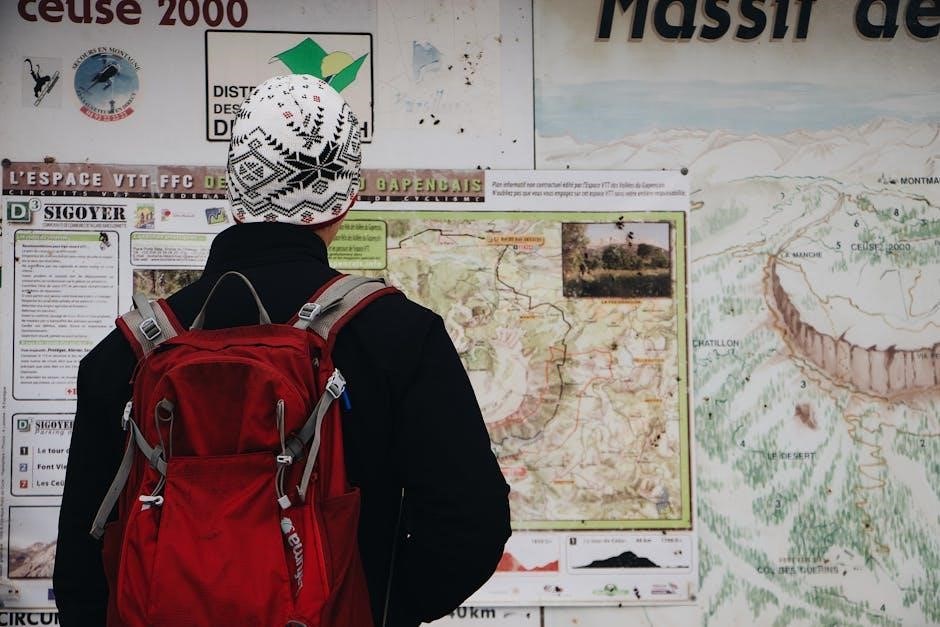Sleeping bag temperature ratings are crucial for ensuring comfort and safety in various outdoor conditions․ The ISO test measures thermal performance, providing Comfort, Limit, and Extreme ratings to guide users․ These ratings help determine the ideal range for different adventures, balancing warmth and lightweight design․ Understanding these standards ensures you stay warm and cozy, no matter the weather․
Why Understanding Temperature Ratings Matters
Understanding sleeping bag temperature ratings is essential for ensuring comfort and safety during outdoor adventures․ These ratings help you choose the right bag for specific conditions, preventing overheating or hypothermia․ The ISO test provides standardized measurements, offering insights into a bag’s performance․ Comfort, Limit, and Extreme ratings cater to different needs, ensuring you stay warm in varying temperatures․ Accurate ratings also prevent overpacking andsave money by avoiding unnecessary features․ Personal factors like metabolism and sleep position further influence how ratings apply to you․ Grasping these details ensures you select a bag that meets your specific requirements, enhancing your camping experience․
The ISO Test and Its Importance
The ISO test is a standardized method for measuring sleeping bag performance, ensuring consistency across brands․ It evaluates thermal insulation by simulating human heat loss in controlled conditions․ The test results in three ratings: Comfort, Limit, and Extreme, providing clear guidelines for users․ This certification helps consumers compare products fairly and make informed decisions․ The ISO standard is globally recognized, offering reliability and transparency․ By adhering to this test, manufacturers ensure their bags meet rigorous quality and safety standards, which is vital for outdoor enthusiasts relying on their gear in extreme conditions․

Key Types of Temperature Ratings
Sleeping bags feature three main temperature ratings: Comfort, Limit, and Extreme․ These ratings indicate the range of temperatures for optimal warmth and safety in various conditions․
Comfort Rating: What It Means for You
The Comfort Rating represents the lowest temperature at which a sleeping bag will keep an average person warm in a relaxed position․ It is typically used for women’s bags, as it accounts for colder sleepers․ This rating ensures you stay comfortable without overheating, making it ideal for most camping scenarios․ When choosing a bag, consider adding a 10°F buffer to the expected low temperature for safety․ This rating is crucial for balancing warmth and versatility, ensuring your sleeping bag performs well in real-world conditions while maintaining a comfortable sleeping environment․
Limit Rating: Understanding the Threshold
The Limit Rating signifies the lowest temperature at which a sleeping bag can maintain thermal equilibrium, typically for men․ It represents the threshold where a sleeper might start to feel cold․ This rating is crucial for understanding the bag’s performance in colder conditions․ The Limit Rating is tested under standardized conditions and provides a clear boundary for safe use․ It helps users plan for extreme weather and ensures they have a safety margin in unpredictable environments․ This rating is essential for adventurers needing reliable gear in challenging climates, ensuring warmth and comfort at the edge of the bag’s capabilities․
Extreme Rating: Survival in Harsh Conditions
The Extreme Rating represents the lowest temperature a sleeping bag can withstand in life-threatening conditions, ensuring survival rather than comfort․ This rating is a critical threshold for adventurers facing extreme cold․ It is typically 10-20 degrees lower than the Limit Rating and is measured under standardized testing․ The Extreme Rating serves as a last resort for survival in harsh environments, where hypothermia is a risk․ It is not intended for regular use but provides a safety net in emergencies․ Understanding this rating is vital for explorers venturing into arctic or high-altitude conditions, ensuring they are prepared for the most severe cold․

Factors Influencing Sleeping Bag Temperature Ratings
Fill type, sleeping pad use, and gender differences significantly influence a sleeping bag’s temperature rating, affecting its performance in diverse outdoor conditions․
Fill Type: Down vs․ Synthetic
The type of insulation in a sleeping bag significantly impacts its temperature rating․ Down fill offers excellent warmth-to-weight ratio and compressibility, making it ideal for cold-weather and lightweight applications․ However, down loses insulating properties when wet․ Synthetic fill, on the other hand, retains warmth even when damp, making it better for wet conditions, though it is generally heavier and bulkier․ The choice between down and synthetic depends on the expected weather conditions and the user’s preference for weight versus moisture performance․ Both materials are widely used, with down favored for high-end, cold-weather bags and synthetic for durability in wet climates․
Sleeping Pad Impact on Bag Performance
A sleeping pad plays a crucial role in enhancing a sleeping bag’s temperature rating by providing insulation from the ground․ The pad’s ability to reduce heat loss directly impacts the bag’s overall warmth․ Higher-quality pads with better R-values (thermal resistance) improve the bag’s performance in cold conditions․ A well-fitted pad also ensures proper air circulation inside the bag, preventing heat from escaping․ Using a compatible pad tailored to the bag’s insulation capabilities maximizes its temperature rating efficiency․ Neglecting a suitable pad can lower the bag’s effectiveness, making it feel less warm than its rated capacity․ Thus, a good pad is essential for optimal performance in the field․
Gender Differences in Ratings
Gender differences play a role in sleeping bag temperature ratings, as men and women experience cold differently․ Comfort ratings often align with women’s preferences, as they tend to feel colder at lower temperatures․ The ISO test assigns separate thresholds for men and women, with women’s Comfort ratings typically being higher․ Men, on average, may find the same bag warmer due to differences in metabolism and body composition․ These distinctions help tailor bags to individual needs, ensuring optimal warmth and comfort․ Understanding these gender-specific ratings can enhance your purchasing decision, making sure the bag suits your personal comfort levels in various conditions effectively․
Standardized Testing and Certification
Standardized testing and certification, such as ISO and EN ratings, ensure sleeping bags meet specific thermal performance standards, providing reliable and consistent temperature ratings for consumers․
The EN Rating System Explained
The EN (European Norm) rating system provides standardized temperature ratings for sleeping bags, ensuring consistency across brands․ It measures thermal performance under controlled conditions, resulting in Comfort and Limit ratings․ The Comfort rating indicates the lowest temperature for a comfortable night’s sleep, typically for women, while the Limit rating is the extreme temperature a bag can handle, usually for men․ Bags are tested in a laboratory setting with heated mannequins to simulate real-world conditions․ These ratings help consumers make informed decisions based on their needs, ensuring they stay warm in various outdoor environments․
How Bags Are Tested for Thermal Performance
Sleeping bags undergo rigorous testing to determine their thermal performance․ The ISO test uses heated mannequins to simulate human heat loss, measuring how well the bag retains warmth․ The mannequins are dressed in standardized clothing and placed inside the bag in a controlled, cold chamber․ Sensors record temperature fluctuations over several hours․ The results define the Comfort, Limit, and Extreme ratings․ This method ensures consistent and reliable data, helping consumers choose the right bag for their needs․ The process evaluates insulation efficiency, fabric performance, and overall warmth retention in various conditions․
Choosing the Right Temperature Rating
Choosing the right temperature rating balances season, conditions, and personal comfort․ Consider buffer zones for safety and select based on adventure type, from summer camping to extreme expeditions․
Seasonal Considerations: 2-Season vs․ 4-Season Bags
Seasonal considerations are vital when selecting a sleeping bag․ 2-season bags are ideal for warmer weather, typically suitable for spring and summer nights with temperatures above freezing․ They are lightweight and compact, perfect for backpacking and camping in mild conditions․ On the other hand, 4-season bags are designed for year-round use, including cold winter nights․ These bags offer superior insulation and are heavier due to their advanced materials and construction․ Choosing between them depends on your adventure type, whether you need versatility for all seasons or efficiency for specific warmer conditions․
Real-World Application: Buffer Zones and Safety Margins
Understanding buffer zones and safety margins is essential for practical use of sleeping bags․ A buffer zone refers to the temperature difference between the bag’s rating and the actual outdoor conditions․ Experts recommend a safety margin of at least 10°F below the expected low to ensure warmth․ This buffer accounts for variables like wind chill, humidity, and personal comfort․ For example, if the forecast predicts 25°F, choose a bag rated for 15°F․ This approach ensures you stay comfortable even in unpredictable conditions, avoiding the risk of hypothermia․ Always prioritize a slightly lower-rated bag for added safety and reliability in real-world scenarios․

Specialized Bags and Their Ratings
Specialized sleeping bags are designed for extreme conditions, with ratings like winter bags offering -40°C comfort and expedition bags pushing thermal limits for prolonged use in harsh environments․
Winter Sleeping Bags: Extreme Cold Ratings
Winter sleeping bags are engineered for extreme cold, with ratings as low as -40°C for survival in harsh environments․ These bags use high-loft down or advanced synthetic insulation to retain warmth․ Designed for expedition use, they often feature waterproof fabrics and draft-proof collars․ The Marmot Cwm, for example, offers a comfort rating of -40°C, while others may have lower limit ratings for extreme conditions․ These bags prioritize warmth over weight, making them bulky but essential for polar or high-altitude adventures․ Proper fit and features like adjustable hoods ensure maximum thermal efficiency, keeping users safe in subzero temperatures․
Expedition Bags: Pushing the Limits
Expedition sleeping bags are designed for extreme adventures, offering unparalleled warmth in subzero temperatures․ These bags often feature cutting-edge insulation, such as high-fill-power down or advanced synthetic materials, ensuring reliability in harsh conditions․ With ratings as low as -40°C, they cater to mountaineers and explorers facing prolonged exposure to cold․ Key features include waterproof shells, reinforced seams, and adjustable hoods to minimize heat loss․ Expedition bags are heavier and bulkier but provide the necessary protection for survival in extreme environments․ Their construction prioritizes durability and thermal retention, making them indispensable for high-altitude or polar expeditions where staying warm is critical for safety․

Maintenance and Care
Proper cleaning and storage are vital to maintaining a sleeping bag’s insulation and temperature rating․ Hand wash gently, avoid harsh chemicals, and dry thoroughly to preserve loft and warmth․ Store uncompressed in a dry, cool place to ensure long-term performance and reliability in extreme conditions․
How Cleaning Affects Temperature Ratings
Cleaning your sleeping bag can significantly impact its temperature rating․ Proper washing is essential to maintain the insulation’s effectiveness․ Using harsh detergents or excessive heat can damage the fill, whether down or synthetic, reducing its ability to trap warm air․ Over-washing can also strip away treatments like water repellency, further compromising performance․ It’s recommended to clean your bag only when necessary and follow manufacturer guidelines to ensure the insulation remains intact․ Regular spot cleaning and airing out can help maintain the bag’s thermal efficiency without risking damage from excessive cleaning․ This preserves the bag’s ability to retain warmth in cold conditions․
Proper Storage to Maintain Insulation
Proper storage is crucial to maintain your sleeping bag’s insulation and temperature rating․ Store the bag in a dry, cool place, avoiding compression to preserve the loft of the fill․ Use a large, breathable storage sack rather than the stuff sack to allow air circulation․ Avoid storing in attics or basements where moisture and pests may damage the bag; Clean the bag before storing to prevent dirt and oils from degrading the insulation․ Never store a damp bag, as moisture can ruin the fill․ Proper storage ensures the bag retains its thermal performance for future use, keeping you warm in cold conditions․
Selecting the right sleeping bag based on temperature ratings ensures comfort and safety in varying conditions․ Understanding these ratings, from comfort to extreme, helps you make informed decisions for your adventures, guaranteeing warmth and reliability in the outdoors․
Final Tips for Selecting the Perfect Bag
When choosing a sleeping bag, consider your specific needs and the conditions you’ll face․ Opt for a bag with a comfort rating slightly below your expected low temperature for a safety buffer․ If you tend to sleep cold, prioritize a higher comfort rating․ For extreme conditions, expedition bags with lower extreme ratings are essential․ Always check certifications like EN ratings for reliability․ Remember, a sleeping bag’s performance also depends on factors like your sleeping pad and personal metabolism․ Test the bag if possible, and maintain it properly to ensure long-term insulation performance․ Choose wisely to stay warm, safe, and comfortable on all your adventures․
